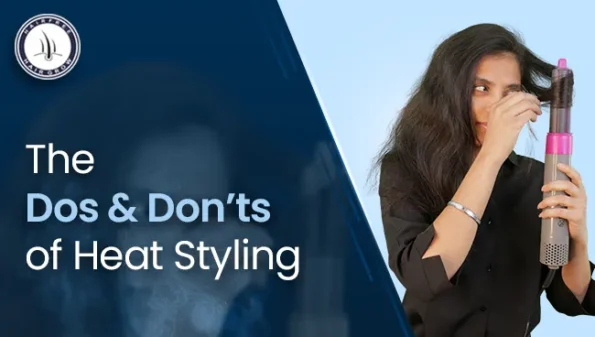Are you tired of dealing with damaged and brittle hair after using heat styling tools? Are you unsure about the right techniques to achieve beautiful, salon-worthy hair without causing harm? Look no further! In this article, we will explore the essential dos and don’ts of heat styling that every hair enthusiast should know. From flat irons to curling wands, we’ll provide expert advice to help you achieve stunning hairstyles while keeping your locks healthy and vibrant.
In a nutshell, the key to successful heat styling lies in understanding the proper techniques and tools to use. By following these guidelines, you can protect your hair from unnecessary damage and maintain its natural shine. Avoiding excessive heat exposure, using heat-protectant products, and allowing your hair to cool down properly are just a few of the crucial factors we will discuss. With this knowledge, you’ll be able to create a variety of stunning hairstyles while keeping your hair healthy and strong.
The Dos of Heat Styling
Use a Heat Protectant
Before applying any heat to your hair, always use a heat protectant spray or serum. These products create a barrier between the heat and your hair, reducing the risk of damage. Spray the protectant evenly throughout your hair, focusing on the ends, where the hair is more prone to dryness and split ends.
Start with Clean and Dry Hair
Ensure that your hair is clean and completely dry before using any heat styling tools. Wet hair is more vulnerable to heat damage as the water trapped inside the strands can turn into steam and cause hair breakage. Give your hair enough time to air dry or use a blow dryer on a low heat setting before proceeding with heat styling.
Adjust the Temperature According to Hair Type
Different hair types require different heat settings. Fine or damaged hair is more delicate and should be styled at a lower temperature, whereas thick or coarse hair may need higher temperatures to achieve the desired style. Always read the instructions of your heat styling tool and choose the appropriate temperature setting accordingly.
Divide Hair into Sections
When styling your hair, divide it into smaller sections. This allows for better heat distribution and ensures that each section is thoroughly styled. Use clips or hair ties to keep the sections separated, and work on one section at a time.
Use the Right Tools
Invest in high-quality heat styling tools that are suitable for your hair type. Ceramic or tourmaline plates distribute heat evenly and minimize damage. Additionally, consider the size of the tool. Smaller barrels are ideal for creating tight curls, while larger barrels are better for loose waves or straightening.
The Don'ts Of Heat Styling
Don't Use High Heat Settings
Using excessive heat can cause irreparable damage to your hair. Avoid using the highest heat settings on your styling tools unless absolutely necessary. Start with the lowest setting and gradually increase the temperature if needed, but always prioritize the health of your hair over achieving a quick result.
Avoid Heat Styling on Wet Hair
Never use heat styling tools on wet or damp hair. Wet hair is more susceptible to damage as it is more fragile and prone to breakage. Allow your hair to dry completely before applying any heat. If you’re in a hurry, use a blow dryer on a low heat setting or opt for air drying.
Don't Overdo It
Excessive heat styling can lead to over-processing and damage. Limit the frequency of heat styling sessions to give your hair time to recover and maintain its natural health. Embrace no-heat styling alternatives like braids, buns, or natural air drying to give your hair a break.
Avoid Heat Styling Daily
Using heat styling tools every day can be detrimental to the health of your hair. Constant exposure to heat can strip away the natural oils, leaving your hair dry and brittle. Try to minimize heat styling to two to three times a week and use non-heat styling methods in between.
Don't Neglect Hair Care
Heat styling can take a toll on your hair, so it’s crucial to provide it with proper care. Use nourishing shampoos and conditioners that are specifically formulated for heat-damaged hair. Additionally, incorporate deep conditioning treatments and hair masks into your routine to replenish moisture and repair any damage.
Final Note
Heat styling can be a fantastic way to transform your hair and create stunning looks. However, it’s important to follow the dos and don’ts to protect your hair from potential damage. Always use a heat protectant, adjust the temperature according to your hair type, and avoid excessive heat styling. Remember to give your hair regular breaks and provide it with the care it needs to remain healthy and beautiful.
FAQs
How often should I use heat styling tools?
It is best to limit heat styling to two to three times a week to minimize damage. Give your hair time to recover and use alternative no-heat styling methods in between.
Can I use heat styling tools on wet hair?
No, heat styling tools should never be used on wet or damp hair. Wet hair is more prone to damage and breakage. Ensure your hair is completely dry before using any heat.
Is it necessary to use a heat protectant?
Yes, using a heat protectant is crucial to minimize damage caused by heat styling. It creates a barrier between the heat and your hair, reducing the risk of breakage and dryness.
What temperature should I use for heat styling?
The temperature you should use depends on your hair type. Fine or damaged hair should be styled at lower temperatures, while thick or coarse hair may require higher temperatures. Adjust the temperature accordingly.
How can I repair heat-damaged hair?
To repair heat-damaged hair, incorporate deep conditioning treatments, hair masks, and nourishing products into your hair care routine. These will help replenish moisture and repair any damage caused by heat styling.
Written By
MBBS, DDV
Dr Jinkal Kunjadiya is Board-certified surgeon recognized for pioneering techniques in hair transplants. His main area of focus is on factors such as heat styling or using hair dryer on hair and dealing with it with his expertise.
Disclaimer
We’ve made all possible efforts to ensure that the information provided here is accurate, up-to-date and complete, however, it should not be treated as a substitute for professional medical advice, diagnosis or treatment. See Detailed Disclaimers Here.



